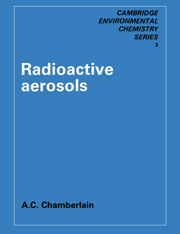7 - Studies with radioactive particles and human subjects
Published online by Cambridge University Press: 12 September 2009
Summary
Introduction
Concern about possible inhalation hazards was felt at an early stage in the development of the nuclear industry. Experiments were done with animals to study deposition of radioactivity in the lung, entry into the bloodstream and transfer to organs of concentration. Information has also been obtained from cases of accidental human exposure. The Task Group on Lung Dynamics (1966) reviewed these data and formulated recommendations on which are based the permissible levels of airborne activity.
No attempt is made here to review the basis of these recommendations, but some human studies with radioactive aerosols are described, with particular reference to those relevant to exposure to atmospheric pollutants, such as tobacco smoke and lead aerosols.
The effects of inhaled particles depend on the deposition in the upper airways and in the lung.
The Task Group on Lung Dynamics (1966) considered the respiratory tract as consisting of three compartments (Fig. 7.1):
(i) Naso-pharyngeal (NP) region, or upper respiratory tract. This comprises the nose, mouth, naso-pharynx and oro-pharynx.
(ii) Tracheo-bronchial (TB) region. This begins at the larynx, and comprises the trachea, bronchi and bronchioles. The branching airways are smaller and more numerous at each division, ending with the terminal bronchioles which are about 0.5 mm in diameter.
(iii) Pulmonary (P) or alveolar region. The respiratory bronchioles and alveoli perform the function of the lung in exchanging oxygen and CO2.
- Type
- Chapter
- Information
- Radioactive Aerosols , pp. 228 - 252Publisher: Cambridge University PressPrint publication year: 1991



